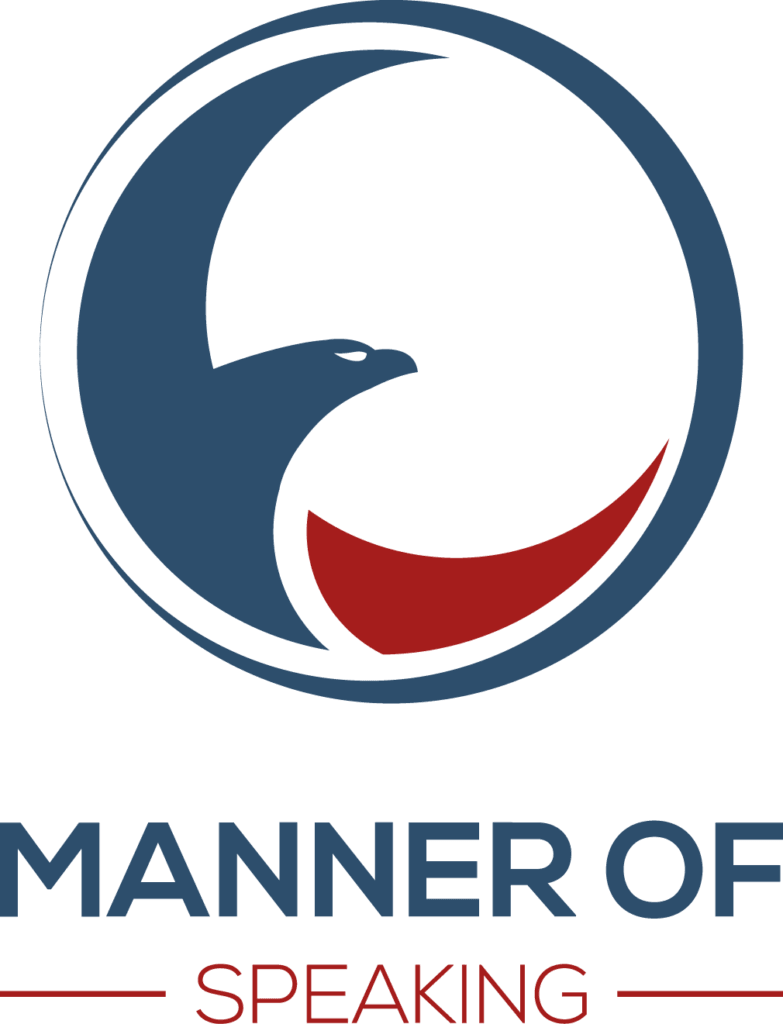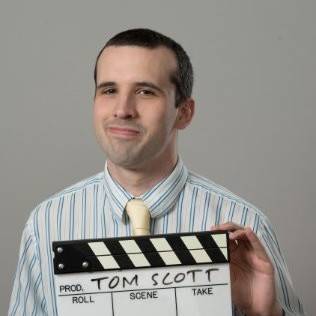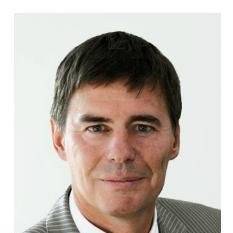Many companies unwittingly hinder the effectiveness of their employees’ presentations because of policies that mandate the use of corporate slide templates on every PowerPoint or Keynote slide.
Without question, a well-designed template can make a slide presentation look professional and polished. And, it is understandable that companies want to display their brand name and logo as often as they can. However, the focus on brand promotion can have unintended negative consequences.
Consider the slide below.
It is typical of many corporate slides that I have seen. There is a bar across the top (usually in the company’s colours) with a logo justified to the right. There are, of course, variations, with bars (or other designs) across the bottom or along the side.
At first blush, it seems fine, but there is a problem: The black bar in the slide above takes up approximately 21% of the entire slide surface. That leaves just 79% in which to fit text, pictures, charts, etc. The result is predictable: smaller text that is harder to read; smaller photographs that make less of an impact; smaller charts and graphs that are more difficult to understand.
Is it really necessary to have a corporate logo on every slide? Do you really need to remind your audiences 10, 20, 30 or more times that you work for ABC Company? Chances are, the audience knows where you work.
In my view, creating a compelling presentation that uses the entire slide surface to make an impact will benefit your company more than having a logo on every slide. Indeed, the logo is often a distraction from the main message on the slide.
I recognize that many presenters do not have a say in the matter. They must use the company template. In such cases, here are some ideas to keep in mind:
- Keep the text on any one slide to a minimum (which you should be doing in any event) in order to be able to use the largest font possible (30 point minimum).
- Seek permission to abandon the template for charts and graphs. Use the entire slide surface. The objective is to make the data easier for the audience to understand. Bigger = Clearer = Easier to Understand.
- If possible, use the entire slide surface for compelling images. Keep the size of logos to a minimum and place them in a corner.
- If you must use a reduced slide surface for an image, be sure to use a high quality image, the resolution of which will not be diminished.
- For the longer term, work to change either the corporate policy or the slide templates. For example, the policy could be that the logo must appear on the first and last slides only. Or, perhaps the logo could be reduced in size or confined to a corner in order to yield more working space. Clearly, this last idea will be easier to achieve in a smaller company than a multinational, but every great innovation begins as an idea. Why can’t it begin with you?

















Thanks for the post, John.
I’m guilty as charged with my biz presentations. I have a template, and I use it much of the time.
Having said that, and being independent, I break the rule when need be. Isn’t that, um, what rules are for?
Hey Jack. True, but I’ve seen a couple of your presentations and you don’t cram your slides with information. And, being independent, you have to hustle for your work constantly and branding – something you understand very well – is a key aspect of that hustling. Still, I think that even independent professionals can go “full slide” for some of the slides in a presentation. For example, in a 20-slide presentation with, say, 5 charts, one could drop the logo for the five slides with the charts and keep it for the remaining 15. Like you say, rules are meant to be stretched and broken. The key to doing so successfully is to understand the rule in the first place!
Cheers!
John
Good article John. This is a problem I’ve run into a lot of times, but always took the constraint of the “corporate template” as a given as opposed to questioning it.
It should be noted that one of the reasons that the slides have the corporate logo on it is in the situation where someone outside your company presents them. For example, a salesperson often sends a slide deck to a potential customer after a meeting. In this way it serves as a method to remind the viewer about your company and to make it slightly harder and more obviously unethical for someone to re-purpose your slides for a purpose you would not condone (such promoting a competitor).
It seems to me this brings up a larger branding problem that many large companies have. Ideally simply the color scheme of the slides would identify the company, but otherwise a subtle logo in the corner (such as the Twitter bird, the McDonald’s Golden Arches, the Nike swoosh etc.) would be sufficient.
Thanks very much for the comment. You touch upon an important point that I purposely left out to keep the post short. But now you’ve forced my hand! 😉 I certainly understand the concern about distributing copies of the slide presentation. My view on the matter is that you should almost never distribute your slides. If they are done properly, they will not be nearly as effective without the presenter. This does not mean that you should not hand out anything. To the contrary, I encourage people to have detailed handouts (a) because they can cram as much detail into them as they want to for people to digest on their own; and (b) it will help to relieve them of the feeling that they have to put everything on the slides. Of course, if you have a key customer or a potential major customer and they ask for the slides, by all means, distribute them!
You’re right, sir. I hate (strongly dislike?) crammed slides. But you touched on something, and you’re causing me to re-think my existing templates.
I’ve got a background that includes branding, and I think slides that have a unique brand feel about them is very good. I’ve been thinking of changing my templates, though, to give me a little more space. My templates are six years old, and maybe I just need to change for the sake of it, and in the process, give myself a few more cm2.
Thanks again!
Jack
Amen!
I find there are many other things people for some mysterious reason think is important to repeat. Actually maybe the problem is that they don’t think. The first example that springs to mind is at conferences repeating the conference name, date (and sometimes even presentation title!). When I am in the audience I feel slightly insulted that the person thinks I am going to forget which conference I am attending (or which company he/she is from).
I agree 100% with your view that slides (as-is at least) should seldom need to be distributed. If you expect a lot of requests maybe its time to prepare a “presentation set” without logos etc. and a “handout set” with logos, although proper writing with the slides (maybe a notes view printout). I also tend to distribute slides (on the rare occasion) in pdf format to make re-purposing a bit more difficult. But mostly I don’t actually mind too much if people steal my ideas/slides, to the contrary that’s sometimes very satisfactory – of course, for others the stakes may be much higher and the game very different.
Thanks for the comment, Reinhardt. Part of the issue, I think, is that we have done things the same way for so long, that it feels uncomfortable to change them. However, it is the people who break with convention who get noticed (though, admittedly, not always for good reasons!).
I don’t usually distribute slides to the audience (though I give the conference organizer a set for their records) but I do have a detailed handout that I give (electonically) with my notes and links to relevant and useful sites.
John
Good conversation, and Hi Clinton!
As to the last point about passing out handouts, I’ve suggested to one of my clients who could not avoid doing it, to
– first write out the presentation bullets as long hand as need be (but even then resist)
– save that file, that’s your handout
– open that file and save it to a new name, e.g. actual_presentation
– cut the new file down, and down, and down, and down
– slides with ONE WORD, ONE PHOTO, ONE PHRASE, for example
Ah yes, the handout. If you’re going to present to the same group? Do not hand out the handout until AFTER the presentation!
Have a great day, guys!
Great ideas, Jack and worth noting.
John
Hello John,
Great article as usual. As a public speaker, I agree with you. But coming from a large corporation and working as an engineer, I have some reservation.
The company I work for employs nearly 80,000 individuals worldwide. If individuals had freedom to deliver their slides as they wish, without a doubt we would see some really amazing and creative presentations. However, most would not and their presentations will be at the other end; i.e with the common mistakes and bad individualism that you’ve mentioned numerously on your blog. In the company’s perspective, it is worth sacrificing these few award winning presentations in the name of consistency. I agree that some companies need to review their template, especially when the company logo takes most of the slide (as you have pointed).
Another reason is copyright. I know it may not seem logical to some types of presentation but if I were to present a technical presentation, containing algorithms, telecoms architecture or system proposals to a client who also deals with our competitors as well, our logo needs to be embedded on each slide, especially when it is imperative that presentation file would be distributed.
For these reasons I believe that templates and logos are crucial in the corporate world.
Excellent comments, Faisal. Thank you.
You’re absolutely right about the need for companies – especially large ones – to have certain standards in order to ensure a minimum level of quality. My “plea” to them was to have a rethink at the corporate level.
As a lawyer, I also understand the concern about copyright (although there are conventions in place guaranteeing certain rights even without the word “copyright” being present). Even here, though, it would not take much effort to have one slide set that is shown, without big logos or “copyright” and a second set for distribution with all the corporate safeguards in place. Better yet, and as mentioned, is to have a handout with all the details and the copyright caveat on each page.
Thanks again for moving the conversation forward.
John
Your plea is definitely justified and you are right about copyrights as well (I am not saying this because I am of no match against a lawyer of your calibre :)). I totally agree with you regarding the distribution of slides. It’s too easy to copy from Power Point slides, thus copyright information and logos are redundant. An alternative for distribution can be PDF slides. They are as good as static Power Point slides.
Right you are, Faisal. And good point about PDF slides. I know that Keynote has a great export function that lets you convert a Keynote presentation slide deck into a PDF, TIFF file, JPEG file or other formats with just the click of a button.
Hello there,
I have seen all your comments, and because I’m a public speaker and an MS Office IT Trainer, and I help companies to create templates, I’m always amazed to see that most of the time in 2011, people do not use the new themes features that help to create a presentation which will be consistent in font, colors, fading, etc. They should be trained and not use something which is 6 years old or even older.
And the other thing that I keep seeing in my powerpoint classes: People do not know how to create it, and I have included in every ppt class, a good 20 minutes on what is a powerful powerpoint presentation and almost of them write down every single word I say. That might mean companies should train their presenters better.
Thank you for the comment, Delphine. And thank you for doing your part to help make the world’s slide presentations a little bit better!
Thanks for this informative content. A good presentation is a combination of professional slides and great delivery. While a lot of training focuses on delivery, not many focus on good slide design.
Thank you for the comment. You are right. A good presentation is the result of a number of things: preparation, content, design, delivery, etc. Falling short in just one area can greatly reduce the effectiveness of the presentation.